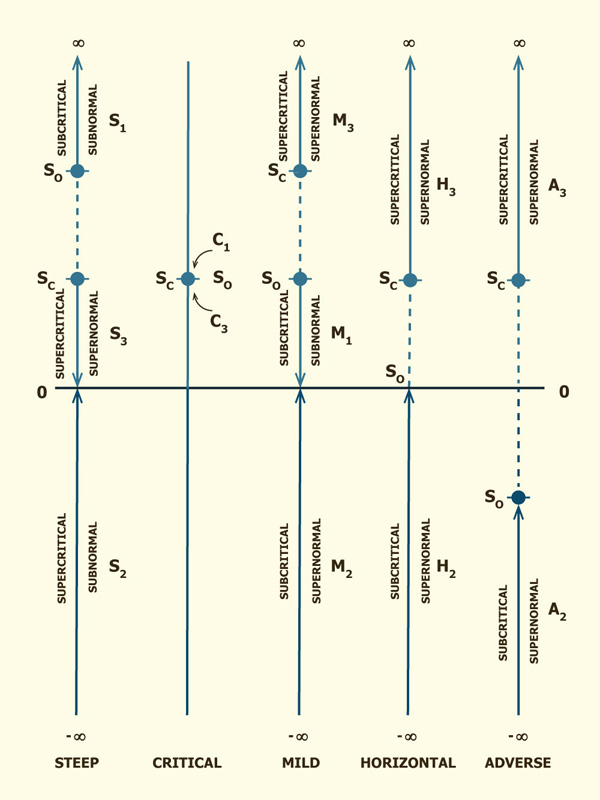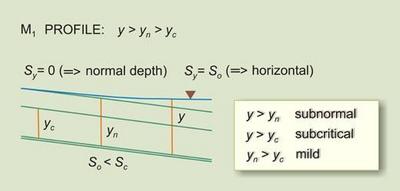dy So - Sc F 2
___ = ___________
dx 1 - F 2
| (6) |
which is strictly valid for the following condition: P /T
= Pc /Tc . This latter
condition is generally satisfied in a hydraulically wide channel,
for which T is asymptotically equal to P.
For ease of expression, the flow-depth gradient is renamed Sy = dy/dx. Solving for Froude number from Equation 6:
So - Sy
F 2 = _________
Sc - Sy
| (7) |
|
Since F 2 > 0, the flow-depth gradient must satisfy the following inequalities:
which effectively limits the flow-depth gradient to values outside the range encompassed by So and Sc. Furthermore, Equation 6 can be alternately expressed as follows:
Sy ( So / Sc ) - F 2
___ = ______________
Sc 1 - F 2
| (10) |
|
Equation 10 is the GVF equation in terms of bed slope So , critical slope
Sc , and Froude number F. The bed slope could be positive
(steep, critical, or mild), zero (horizontal), or negative (adverse). The critical
slope (Equation 5) and Froude number squared (Equation 3) are always positive.
3. CLASSIFICATION OF WATER-SURFACE PROFILES
Equation 10 is used to develop a classification of water-surface profiles based solely
on the three dimensionless parameters: Sy /Sc ,
So /Sc , and F. For the sake of completeness,
subcritical flow is defined as that for which the flow depth is greater than the critical
depth (F 2 < 1) (Chow 1959; Henderson 1966). Paralleling this widely accepted
definition, subnormal flow is defined as that for which the flow depth is greater than
the normal depth [F 2 < So /Sc ].
Supernormal flow is defined as that for which the flow depth is smaller than
the normal depth [F 2 > So /Sc ]
(USDA SCS 1971). Table 1 shows the four (4) classes of water-surface profiles and the twelve (12)
possible profiles.
Table 1. Possible classes and types
of water-surface profiles.
|
| CLASS 1: SUBCRITICAL/SUBNORMAL
|
|
- Steep: S1
- Critical: C1
- Mild: M1
| CLASS 2A: SUPERCRITICAL/SUBNORMAL
|
|
| CLASS 2B: SUBCRITICAL/SUPERNORMAL
|
|
- Mild: M2
- Horizontal: H2
- Adverse: A2
| CLASS 3: SUPERCRITICAL/SUPERNORMAL
|
|
- Steep: S3
- Critical: C3
- Mild: M3
- Horizontal: H3
- Adverse: A3
| | | |
A summary of the twelve possible water-surfaces profiles is shown in Table 2.
The classification follows directly from the governing equation (Equation 10).
It is seen that the general class of profile (Class 1, 2A, 2B, or 3)
determines the sign of Sy /Sc (Column 2) and,
thus, the classification of either backwater or drawdown (Column 3). Also, the general class
of profile determines the feasible range of So /Sc
(Column 4) and, thus, the existence of specific profiles types (Steep, Critical, Mild, Horizontal,
or Adverse) within each general type. Note that not all combinations
of Sy /Sc and
So /Sc are feasible.
Unlike the description available in standard references (Chow 1959; Henderson 1966),
the flow-depth gradient ranges (Table 2, Columns 7 and 8) are now complete for all
twelve water-surfaces profiles. Significantly, the flow-depth gradient Sy is
shown to be outside the range encompassed by Sc and So .
Figure 1 shows a graphical representation of flow-depth gradient ranges in the water-surface
profiles. The arrow shows the direction of computation. For instance, the depth gradient for
the S3 profile (supercritical/supernormal) decreases from Sc
(a finite positive value) to 0 (asymptotic to normal flow). Likewise, the depth gradient
for the C1 (subcritical/subnormal) and C3
(supercritical/supernormal) profiles is constant and equal to So = Sc .
Online water-surface profile calculators are enabled in Table 2.
Table 2. Classification of water-surface profiles.
[Click on any profile type on Col. 9 to link to online water-surface profile calculator]
|
No.
(1)
| Sy /Sc
(2)
| Profile
(3)
| So /Sc
(4)
| Slope
(5)
| Depth
relations
(6)
| Sy varies
| Profile
type
(9)
From
(7)
| To
(8)
|
| 1. SUBCRITICAL/SUBNORMAL FLOW 1: 1 > F 2 < So / Sc
|
| 1
| Positive
| Backwater
| > 1
| Steep
| y > yc >
yn
| So
| ∞
| S1
| 2
| Positive
| Backwater
| = 1
| Critical
| y > yc = yn
| So = Sc
| So = Sc
| C1
| 3
| Positive
| Backwater
| < 1; > 0
| Mild
| y > yn
= yc
| So
| 0
| M1
2A. SUPERCRITICAL/SUBNORMAL FLOW 2: 1 < F 2 < So / Sc
| 4
| Negative
| Drawdown
| > 1
| Steep
| yc > y >
yn
| - ∞
| 0
| S2
2B. SUBCRITICAL/SUPERNORMAL FLOW 3: 1 > F 2 > So / Sc
| 5
| Negative
| Drawdown
| < 1; > 0
| Mild
| yn > y >
yc
| - ∞
| 0
| M2
| 6
| Negative
| Drawdown
| = 0
| Horizontal
| y > yc ;
yn → ∞
| - ∞
| So = 0
| H2
| 7
| Negative
| Drawdown
| < 0
| Adverse
| y > yc ;
yn → ∞
| - ∞
| So < 0
| A2
3. SUPERCRITICAL/SUPERNORMAL FLOW 4: 1 < F 2 > So / Sc
| 8
| Positive
| Backwater
| > 1
| Steep
| yc > yn
> y
| Sc
| 0
| S3
| 9
| Positive
| Backwater
| = 1
| Critical
| yc = yn >
y
| So = Sc
| So = Sc
| C3
| 10
| Positive
| Backwater
| < 1; > 0
| Mild
| yn > yc
> y
| Sc
| ∞
| M3
| 11
| Positive
| Backwater
| = 0
| Horizontal
| yc > y ;
yn → ∞
| Sc
| ∞
| H3
| 12
| Positive
| Backwater
| < 0
| Adverse
| yc > y ;
yn → ∞
| Sc
| ∞
| A3
|
1 Given that So /Sc > F 2 > 0, no horizontal or adverse profiles are possible in subcritical/subnormal flow.
2 Given that So /Sc > 1, no critical, mild, horizontal or adverse profiles are possible in supercritical/subnormal flow.
3 Given that So /Sc < 1, no steep or critical profiles are possible in subcritical/supernormal flow.
4 Given that So /Sc is not limited, all five profiles are possible in supercritical/supernormal flow.
|
| | | | | | | | | | | | | | |

|
Figure 1. Graphical representation of flow-depth gradient ranges
in water-surface profiles.
4. SUMMARY
The gradually varied flow equation is expressed in terms of the critical
slope Sc . In this way, the flow depth gradient dy/dx
is shown to be strictly limited to values outside of the range encompassed
by So and Sc. This completes the definition of
depth-gradient ranges for all water-surface profiles. For instance,
the flow-depth gradient for the S3 profile decreases
from Sc (a finite positive value) to 0 (asymptotic to
normal depth). Likewise, the flow depth gradient for the C1
and C3 profiles is constant and equal to So = Sc.
Table 3 shows a summary of water-surface profiles. Online calculators are provided to round up the experience.
Table 3. Summary of water-surface profiles.
[Click on any image to enlarge]
|
| Family
| Character
| Rule
| So > Sc
| So = Sc
| So < Sc
| So = 0
| So < 0
| 1
| Retarded
(Backwater)
| 1 > F 2 < So / Sc
| S1 |
C1 |
M1 |
- |
- |
| 2A
| Accelerated
(Drawdown)
| 1 < F 2 < So / Sc
| S2
| -
| -
| -
| -
| 2B
| Accelerated
(Drawdown)
| 1 > F 2 > So / Sc
| -
| -
| M2
| H2
| A2
|
| 3
| Retarded
(Backwater)
| 1 < F 2 > So / Sc
| S3
| C3
| M3
| H3
| A3
|
| |
REFERENCES
Chow, V. T. (1959). Open-channel hydraulics. McGraw-Hill, New York.
Henderson, F. M. (1966). Open channel flow. MacMillan, New York.
USDA Soil Conservation Service. (1971). Classification system for varied flow in prismatic channels. Technical Release No. 47 (TR-47), Washington, D.C.
|













